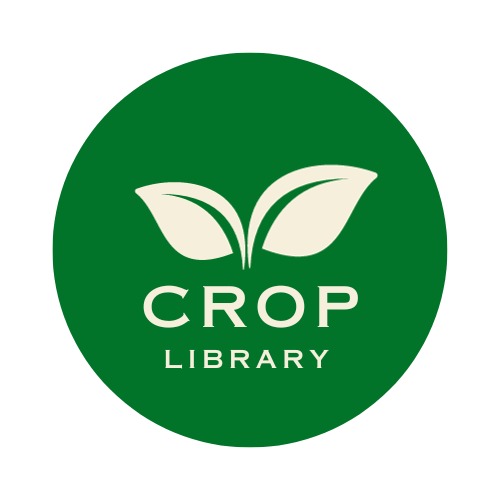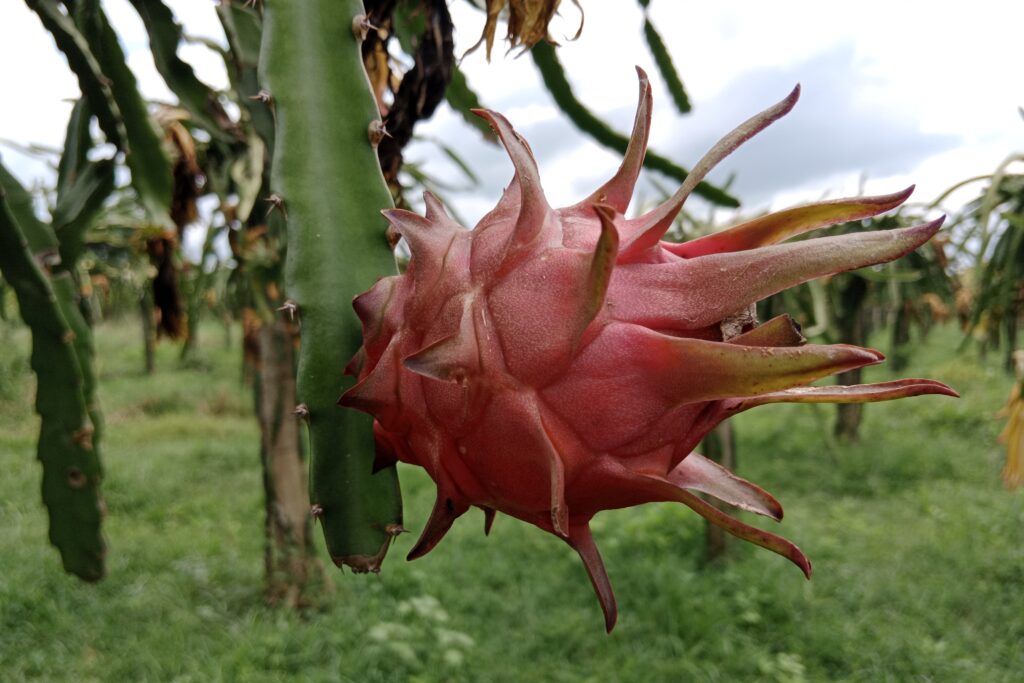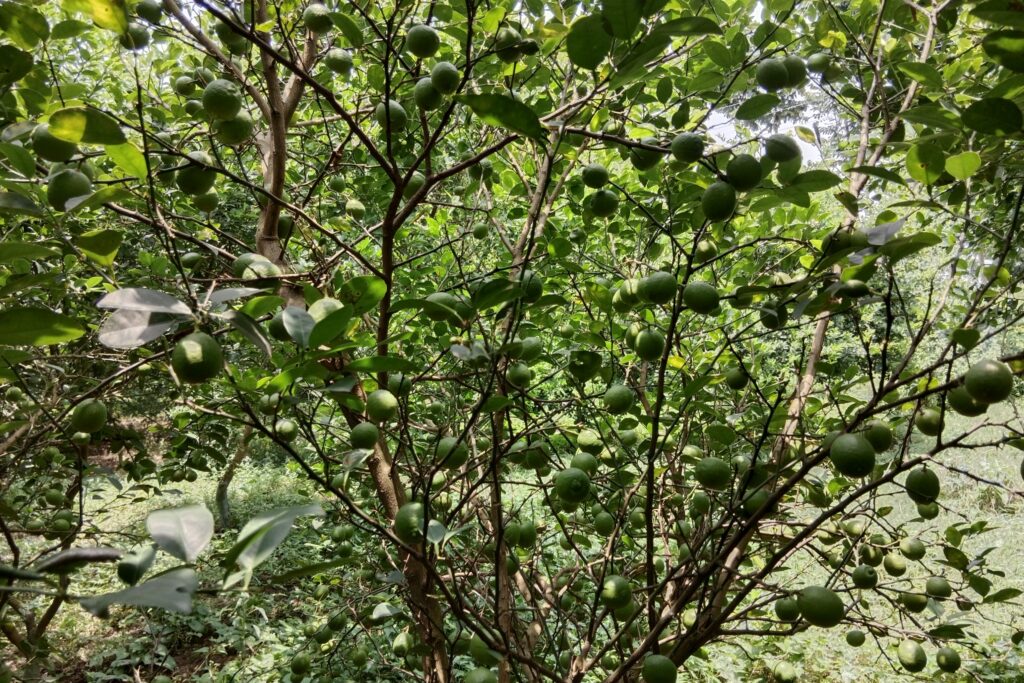Parsley Farming
Parsley (Petroselinum crispum) is a widely grown biennial herb, often cultivated as an annual, valued for its fresh or dried leaves and edible roots. This high-value crop is commonly used for garnishing, enhancing flavors, and for its medicinal properties. Effective cultivation depends on following proper agronomic practices tailored to its growth requirements.
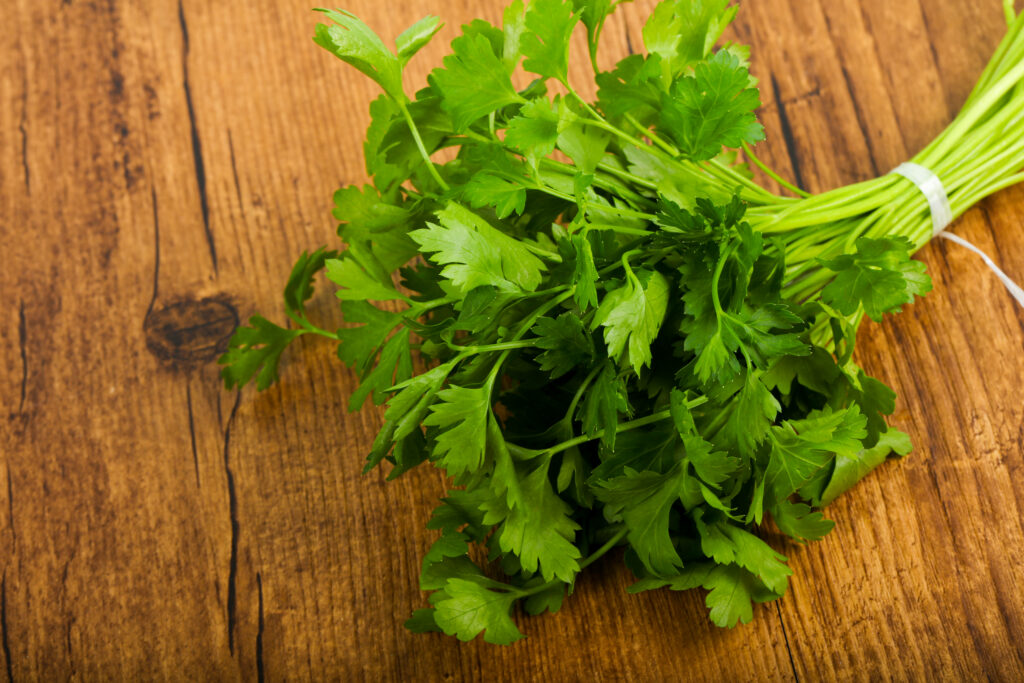
Parsley farming profit per acre can be exceptionally rewarding, offering significant returns for a relatively moderate investment. With a total investment of NRs. 46,000 per acre, farmers can expect a total income of NRs. 200,000 from multiple harvests, resulting in a net profit of NRs. 154,000 and a profit margin of approximately 77%.
When measured in terms of Return on Investment (ROI), calculated as (Net Profit ÷ Total Investment Cost) × 100, the ROI comes to around 335%, which is exceptionally high. These figures highlight that with proper crop management, timely harvesting, and effective pest, disease, and weed control, parsley farming can be a highly lucrative and sustainable agricultural venture.
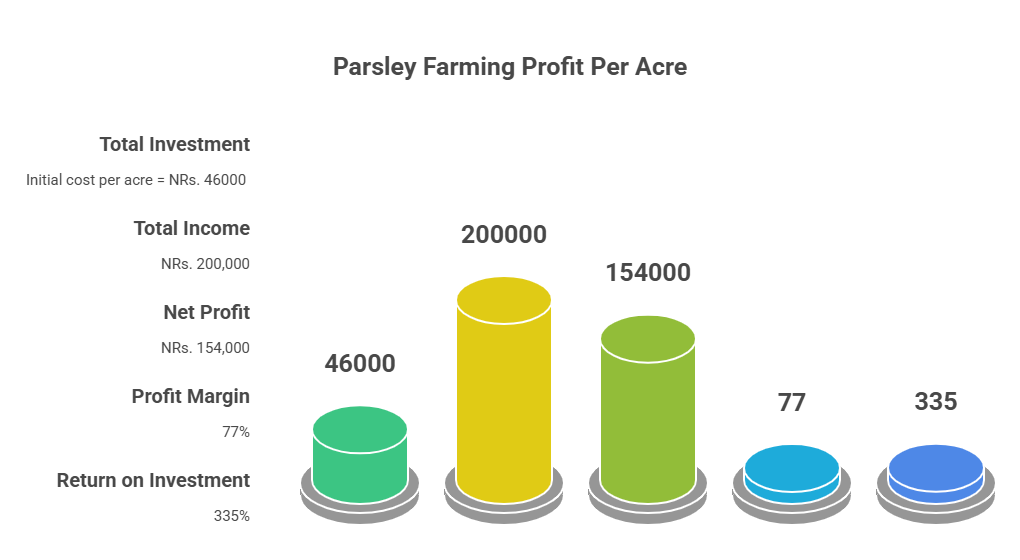
Land Preparation
Proper preparation of the land is vital for successful parsley cultivation, as this herb develops a fine taproot that thrives best in loose, well-aerated soil. The process starts with deep primary tillage, where the soil is loosened to about 15–20 cm using equipment such as a disc harrow or moldboard plough to enhance aeration and promote deeper root growth.
Secondary tillage follows, involving operations like harrowing or rotavation to break down soil lumps and produce a smooth, even seedbed that supports uniform seed placement and sprouting. To improve drainage and field accessibility, raised beds—generally 1 to 1.2 meters wide—are prepared, leaving sufficient pathways between them to facilitate irrigation and crop management activities.
Soil Type
Parsley thrives in fertile, well-drained loamy soil that is rich in organic material, providing favorable conditions for strong root formation and robust plant growth. The crop performs best when the soil pH is maintained between 6.0 and 7.0, though it can tolerate slightly acidic soils to some extent. Efficient drainage is essential, as stagnant water can encourage root decay and fungal infections, which may severely damage or destroy the crop.
Climatic Requirements
Parsley is classified as a cool-season crop that thrives best in temperatures ranging from 15°C to 25°C (59°F to 77°F). While it can tolerate light frosts, prolonged exposure to freezing temperatures can damage its foliage and reduce yield. The crop performs optimally in full sunlight but can also grow well under partial shade, particularly in warmer regions where afternoon shade helps prevent bolting or premature flowering.
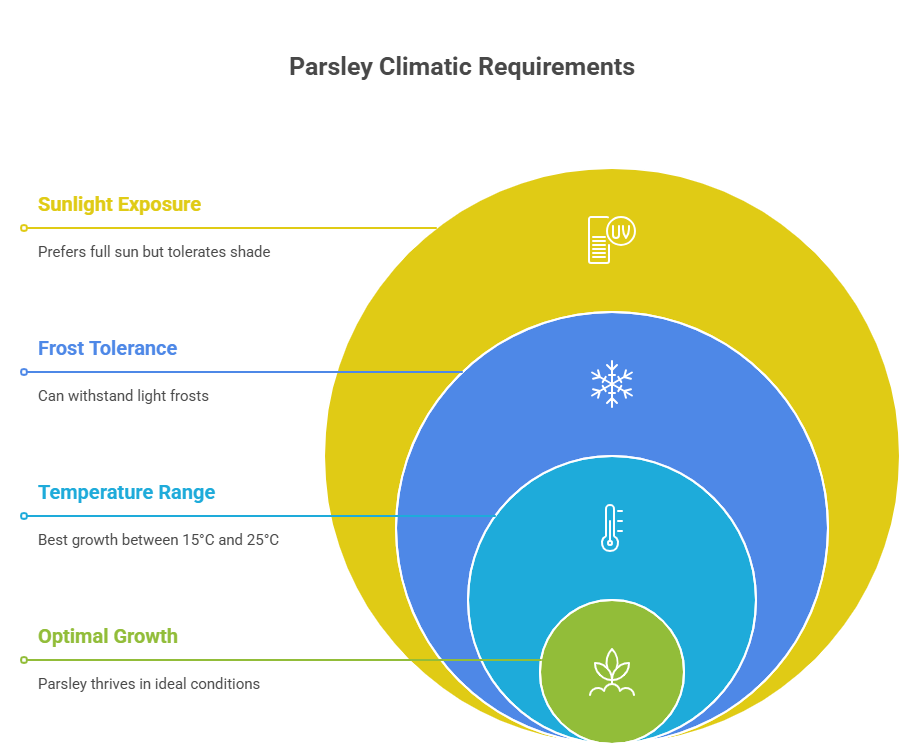
Major Cultivars
There are three main types of parsley, with several cultivars within each:
| Type / Common Name | Botanical Variety | Key Characteristics | Example Cultivars |
| Curly Leaf Parsley | P. crispum var. crispum | Most common for garnishing; has a milder flavor. | ‘Forest Green’, ‘Paramount’, ‘Mooskrause’ |
| Italian / Flat-Leaf Parsley | P. crispum var. neapolitanum | Preferred by chefs for its stronger, more robust flavor. | ‘Giant of Italy’, ‘Titan’ |
| Hamburg / Turnip-Rooted Parsley | P. crispum var. tuberosum | Grown primarily for its large, edible root, which resembles a parsnip. |
Propagation
Parsley is almost exclusively propagated by seeds.
Seed Rate per Acre
The seed rate is 1.5 to 2.5 kg per acre. The variation depends on the cultivar, germination rate, and desired spacing.
Planting
a). Planting Season
In tropical and subtropical regions, this crop is generally planted during the cooler part of the year, often between October and February, when conditions favor better establishment and vigorous growth.
b). Planting Direction
Rows are typically oriented in a North-South direction to maximize sunlight exposure on both sides of the plants.
c). Spacing
| Purpose | Spacing Between Rows | Spacing Between Plants |
| For Leaf Production | 30 – 40 cm | 15 – 20 cm |
| For Root Production | 40 – 50 cm | 20 – 25 cm |
d). Planting Method
The crop can be established either by direct seeding or by transplanting. With direct seeding, seeds are sown in rows at a depth of 0.5 to 1 cm, and the soil must be kept consistently moist until the seedlings emerge. Alternatively, through the transplanting method, healthy seedlings raised in a nursery are carefully moved to the main field; this process is ideally done in the evening or on a cloudy day to minimize transplant shock and ensure better establishment.
e). Number of Plants per Acre
With a spacing of 30 cm x 15 cm, an acre can accommodate approximately 89,933 plants.
Intercropping
Parsley is an excellent crop for intercropping due to its relatively slow initial growth and compact size. It can be intercropped with taller, slow-maturing crops like tomatoes, peppers, or asparagus. This maximizes land use and can help suppress weeds.
Irrigation
Parsley requires consistent moisture without waterlogging, so light and frequent irrigations are ideal, with drip irrigation being highly recommended as it delivers water directly to the root zone, conserves water, and keeps foliage dry to reduce foliar disease risks, while special attention should be given to maintaining adequate moisture during germination, seedling establishment, and after each harvest.
Fertilizer and Manure
A soil test is the most accurate guide for fertilization, but generally, farmers should apply 15–20 tons of well-decomposed farmyard manure or compost per acre during land preparation and incorporate it thoroughly into the soil along with bio-fertilizers like Azospirillum, PSB, and potash-mobilizing bacteria at 800 g each per acre, while for inorganic fertilizers, a balanced dose of 60:40:40 kg per acre of N:P₂O₅:K₂O is recommended, with the full phosphorus and potassium and half of the nitrogen applied as a basal dose and the remaining nitrogen top-dressed in one or two splits after each harvest to promote vigorous regrowth.
Weed Control
Weeds compete aggressively with slow-germinating parsley, so management is essential, with shallow hoeing and hand weeding being effective cultural methods, while applying organic mulch like straw or grass clippings or using black plastic mulch helps suppress weeds and retain soil moisture, and in cases where chemical control is needed, pre-emergence herbicides such as Pendimethalin may be applied after sowing but before weed germination, strictly following label guidelines.
Interculture Operation
Interculture operations in parsley include thinning direct-seeded plants when seedlings reach 5–7 cm to maintain proper spacing and prevent overcrowding, while regular harvesting of outer leaves serves as pruning to encourage fresh central growth, and removing yellow, diseased, or old leaves helps maintain plant health, along with early removal of flower stalks to prevent bolting and ensure energy is directed toward leaf production unless seed harvest is intended.
Flowering and Fruit Management
Parsley, being a biennial, naturally bolts and flowers in its second year under cold exposure and longer days, but for leaf production, bolting is undesirable and can be delayed by selecting slow-bolting cultivars, planting at the appropriate time, and maintaining consistent irrigation without water stress, whereas for seed production, selected plants are allowed to flower and set seeds, which mature unevenly and are harvested when they turn brown.
Pest and Disease Management
Common Pests
Aphids
Aphids are small sap-sucking insects that weaken the plant and can transmit viral diseases. They can be effectively controlled using neem oil at a concentration of 2–3 ml per liter of water, or insecticidal soap at 2–3 ml per liter. For severe infestations, systemic insecticides like imidacloprid can be used at 0.3–0.5 g per liter of water, applied as a foliar spray, following label instructions carefully.
Carrot Weevil
The larvae of carrot weevils feed on the roots, causing significant damage and reducing plant vigor. Cultural practices like crop rotation are the most effective control method, avoiding planting parsley or related crops in the same location consecutively. Keeping the field clean and removing plant residues also helps reduce weevil populations.
Armyworms and Cutworms
These pests feed on leaves and stems, often causing severe defoliation. Biological control agents, such as Bacillus thuringiensis (Bt) at 1–2 g per liter of water, can be applied to control larvae. Alternatively, approved chemical insecticides like carbaryl (1–2 g per liter of water) or deltamethrin (0.5 ml per liter of water) can be used, ensuring proper coverage and adherence to recommended safety guidelines.
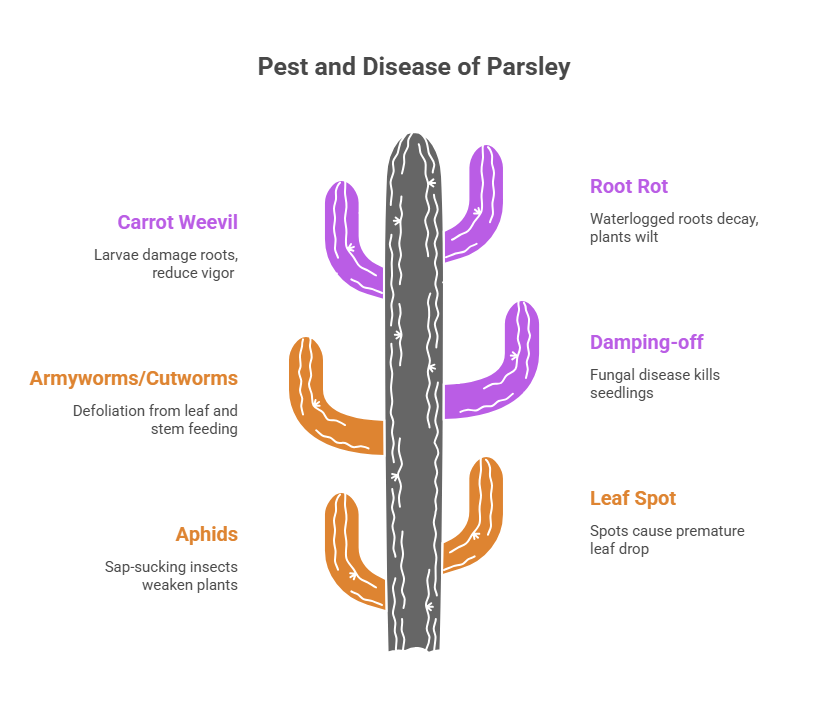
Common Diseases
Damping-off
Damping-off is a fungal disease that affects seedlings, causing them to collapse and die. Prevention is the most effective strategy, including using treated seeds, maintaining well-drained soil, and avoiding overwatering. Fungicides such as Captan or Thiram can be used as a seed treatment at a rate of 2–3 g per kg of seed to protect young seedlings.
Leaf Spot (Septoria/Cercospora)
This disease causes small, circular to irregular spots on the leaves, which may lead to premature leaf drop. Control involves using disease-free seeds, practicing crop rotation, and maintaining good plant spacing for airflow. Fungicides like Mancozeb can be applied as a foliar spray at 2–3 g per liter of water every 10–14 days, especially during wet and humid conditions.
Root Rot
Root rot occurs primarily due to waterlogged conditions, causing roots to decay and plants to wilt. The best preventive measure is improving soil drainage and avoiding excessive irrigation. In severe cases, soil drenching with a fungicide such as Carbendazim at 1 g per liter of water can help manage the pathogen, applied carefully to avoid damage to seedlings.
Harvesting
For leaf parsley, the first light harvest can begin 70–90 days after planting, using either the cut-and-come-again method, where outer mature leaves are cut about 2–3 cm above the crown to allow inner leaves to continue growing with multiple cuttings at 4–6 week intervals, or by harvesting the whole plant at the base when it reaches a marketable size, with the best results achieved by harvesting in the early morning when the plant’s water content is highest to ensure better post-harvest quality.
Yield
A well-managed parsley crop can produce 8,000 to 12,000 kg of fresh leaves per acre through multiple harvests.
Cost of Investment per Acre for Parsley Farming
| S.N. | Category | Cost/Income (NRs.) |
| 1 | Land Preparation | 15,000 |
| 2 | Seed | 1,000 |
| 3 | Seed Sowing | 1,000 |
| 4 | Fertilizers and Manure | 10,000 |
| 5 | Irrigation | 5,000 |
| 6 | Weed Control | 2,000 |
| 7 | Pest & Disease Control | 2,000 |
| 8 | Harvesting | 5,000 |
| 9 | Miscellaneous Costs | 5,000 |
| Total Investment Cost (A) | 46,000 |
Income per acre from Parsley Farming
| Particulars | Estimated Yield / Acre (Kg) | Market Price (NRs./kg) | Total Income (NRs.) |
| Fresh Leaf Yield | 8,000 | 25 | 200,000 |
Analysis of Parsley Farming Profit Per Acre
The total investment for parsley farming per acre is NRs. 46,000, while the total income per acre is NRs. 200,000, resulting in a net profit of NRs. 154,000 and a profit margin of approximately 77%. Return on Investment (ROI), which measures the profitability relative to the money invested, can be calculated using the formula (Net Profit ÷ Total Investment Cost) × 100. Applying this formula, the ROI is (154,000 ÷ 46,000) × 100 ≈ 335%, indicating that parsley farming can be an exceptionally lucrative venture based on these estimates.
Crop Calendar for Parsley Farming
| Phase | Stage / Activity | Timing | Key Actions |
| 1 | Planning & Land Preparation | June – September | – Select a site with well-drained, loamy soil. – Arrange for seeds of a preferred cultivar (Curly, Italian, or Hamburg). – Finalize source of Farmyard Manure (FYM) and fertilizers. |
| 2 | Sowing/Planting Season | October – February | Land Prep: Deep ploughing, harrowing, and forming raised beds. Basal Application: Apply 15-20 tons of FYM and full dose of P & K fertilizers. Sowing: Direct seed (1.5-2.5 kg/acre) at 0.5-1 cm depth with 30×15 cm spacing, or transplant seedlings. |
| 3 | Crop Establishment & Early Growth | Weeks 1 – 12 | Irrigation: Provide light, frequent irrigation, especially during germination. Weed Control: Apply pre-emergence herbicide (if needed) and conduct first weeding. Thinning: Thin seedlings to maintain proper spacing. Pest/Disease Watch: Monitor for damping-off and aphids. |
| 4 | Vegetative Growth & Maintenance | Week 4 onwards | Top Dressing: Apply remaining half of Nitrogen fertilizer after first harvest. Interculture: Regular shallow hoeing, weeding, and removal of old/yellow leaves. Irrigation: Continue consistent moisture via drip or light sprinkling. |
| 5 | Harvesting Period | ~70-90 Days after planting, then every 4-6 weeks | First Harvest: Light harvest of outer leaves. Subsequent Harvests: Use “cut-and-come-again” method for multiple harvests. Best Practice: Harvest in the early morning for best quality. |
| 6 | End of Cycle (for leaf production) | After 5-7 months (or when bolting occurs) | – Conduct final harvest of remaining marketable leaves. – Remove plant debris from the field. – Plan for crop rotation to prevent pest and disease buildup. |
Sources
University of California Agriculture & Natural Resources (UC ANR)
European Plant Protection Organization (EPPO)
Tamil Nadu Agriculture University (TNAU) – Agritech portal
Indian Council of Agricultural Research (ICAR)
Nepal Agricultural Research Council (NARC)
U.S. Department of Agriculture (USDA).
Ministry of Agriculture and Livestock Development (Nepal)
Disclaimer: This crop farming profits assume optimal conditions. Actual results may vary depending on climate, market prices, and farm management practices.
